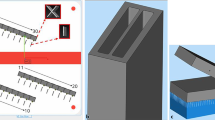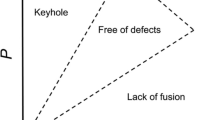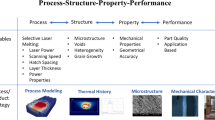Abstract
Laser powder bed fusion (L-PBF) as an additive manufacturing process produces nearly fully dense nickel alloy 625 (IN625) parts with complex features. L-PBF generates surfaces and microstructure through directional solidification that can be controlled by scan strategies and selection of process parameters. This study provides experimental investigations on microstructure formation including sizes of cellular grains and growth directions of columnar grains on the nickel alloy 625 test coupons. The effects of process parameters including laser power, scan velocity, hatch distance, and scan strategy that produce various solidification cooling rates and thermal gradients during the process, which also contribute to resultant microstructure, have been analyzed. Optimization studies are conducted on several objectives to improve the productivity while controlling the process effects on the resultant microstructure using response surface regression, desirability functions, and multi-objective genetic algorithm optimization.
Similar content being viewed by others
References
Amato KN, Gaytan SM, Murr LE, Martinez E, Shindo PW, Hernandez J, Collins S, Medina F (2012) Microstructures and mechanical behavior of Inconel 718 fabricated by selective laser melting. Acta Mater 60:2229–2239
Anam MA, Dilip JJS, Pal D, Stucker B (2014) Effect of scan pattern on the microstructural evolution of Inconel 625 during selective laser melting. Proceedings of 25th Annual International Solid Freeform Fabrication Symposium, August 4–6, 2014, Austin, Texas
Brinksmeier E, Levy G, Meyer D, Spierings AB (2010) Surface integrity of selective-laser-melted components. CIRP Ann Manuf Technol 59(1):601–606
Carter LN, Martin C, Withers PJ, Attallah MM (2014) The influence of the laser scan strategy on grain structure and cracking behaviour in SLM powder-bed fabricated nickel super alloy. J Alloys Compd 615:338–347
Criales L, Arisoy YM, Özel T (2016) Sensitivity analysis of material and process parameters in finite element modeling of selective laser melting of Inconel 625. Int J Adv Manuf Technol In press
Deb K (2001) Multi-objective optimization using evolutionary algorithms. John Wiley & Sons, Inc
Hernandez J, Murr LE, Amato KN, Martinez E, Shindo PW, Terrazas CA, Rodriguez E, Medina F, Wicker RB, Li SJ, Cheng XY, Yang F (2012) Microstructures and properties for a superalloy powder mixture processed by electron beam melting. J Materials Science Research 1:124–144
Hong C, Gu D, Dai D, Alkhayat M, Urban W, Yuan P, Cao S, Gasser A, Weisheit A, Kelbassa I, Zhong M, Poprawe R (2015) Laser additive manufacturing of ultrafine TiC particle reinforced Inconel 625 based composite parts: tailored microstructures and enhanced performance. Mater Sci Eng A 635:118–128
Jia Q, Gu D (2014) Selective laser melting additive manufacturing of Inconel 718 superalloy parts: densification, microstructure and properties. J Alloys Compd 585:713–721
Khairallah SA, Anderson AT, Rubenchik A, King WE (2016) Laser powder-bed fusion additive manufacturing: physics of complex melt flow and formation mechanisms of pores, spatter, and denudation zones. Acta Mater 108:36–45
Krauss H, Zeugner T, Zaeh MF (2014) Layerwise monitoring of the selective laser melting process by thermography. Phys Procedia 56:64–71
Kruth JP, Levy G, Klocke F, Childs THC (2007) Consolidation phenomena in laser and powder-bed based layered manufacturing. CIRP Ann- Manuf Technol 56(2):730–759
Lawrence JR, Pou J, Low DK, Toyserkani E (2010) Advances in laser materials processing: technology, research and application. Elsevier
Li S, Wei Q, Shi Y, Zhu Z, Zhang D (2015) Microstructure characteristics of Inconel 625 superalloy manufactured by selective laser melting. J Mater Sci Technol 31(9):946–952
Liu F, Lin X, Huang C, Song M, Yang G, Chen J, Huang W (2011) The effect of laser scanning path on microstructures and mechanical properties of laser solid formed nickel-base superalloy Inconel 718. J Alloys Compd 509:4505–4509
Mercelis P, Kruth JP (2006) Residual stresses in selective laser sintering and selective laser melting. Rapid Prototyp J 12(5):254–265
Mitchell M (1996) An introduction to genetic algorithms. MIT Press
Murr LE, Gaytan SM, Ramirez DA, Martinez E, Hernandez J, Amato KN, Shindo PW, Medina FR, Wicker RB (2012a) Metal fabrication by additive manufacturing using laser and electron beam melting technologies. J Mater Sci Technol 28:1–14
Murr LE, Martinez E, Amato KN, Gaytan SM, Hernandez J, Ramirez DA, Shindo PW, Medina F, Wicker RB (2012b) Fabrication of metal and alloy components by additive manufacturing: examples of 3D materials science. J Mater Res Technol 1:42–54
Ramos JA, Murphy J, Lappo K, Wood K, Bourell DL, Beaman JJ (2002) Single-layer deposits of nickel base superalloy by means of selective laser melting. Proceedings of 13th Solid Freeform Fabrication Symposium, August 5–7, 2002, Austin, Texas
Thepsonthi T, Özel T (2012) Multi-objective process optimization for micro-end milling of Ti-6Al-4V titanium alloy. Int J Adv Manuf Technol 63:903–914
Ulutan D, Özel T (2013) Multi-objective optimization of experimental and simulated residual stresses in turning of nickel-alloy IN100. Mater Manuf Process 28:835–841
Vilaro T, Colin C, Bartout JD, Nazé L, Sennour M (2012) Microstructural and mechanical approaches of the selective laser melting process applied to a nickel-base superalloy. Mater Sci Eng A 534:446–451
Wang Z, Guan K, Gao M, Li X, Chen X, Zeng X (2012) The microstructure and mechanical properties of deposited IN718 by selective laser melting. J Alloys Compd 513:518–523
Author information
Authors and Affiliations
Corresponding author
Additional information
Official contribution of the National Institute of Standards and Technology (NIST); not subject to copyright in the USA. The full descriptions of the procedures used in this paper require the identification of certain commercial products. The inclusion of such information should in no way be construed as indicating that such products are endorsed by NIST or are recommended by NIST or that they are necessarily the best materials, instruments, software, or suppliers for the purposes described.
Rights and permissions
About this article
Cite this article
Arısoy, Y.M., Criales, L.E., Özel, T. et al. Influence of scan strategy and process parameters on microstructure and its optimization in additively manufactured nickel alloy 625 via laser powder bed fusion. Int J Adv Manuf Technol 90, 1393–1417 (2017). https://doi.org/10.1007/s00170-016-9429-z
Received:
Accepted:
Published:
Issue Date:
DOI: https://doi.org/10.1007/s00170-016-9429-z




